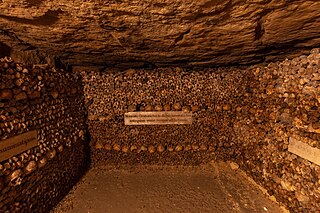
The Catacombs of Paris are underground ossuaries in Paris, France, which hold the remains of more than six million people. Built to consolidate Paris's ancient stone quarries, they extend south from the Barrière d'Enfer former city gate; the ossuary was created as part of the effort to eliminate the effects of the city's overflowing cemeteries. Preparation work began shortly after a 1774 series of basement wall collapses around the Holy Innocents' Cemetery added a sense of urgency to the cemetery-eliminating measure, and from 1788, nightly processions of covered wagons transferred remains from most of Paris's cemeteries to a mine shaft opened near the Rue de la Tombe-Issoire .

Catacombs are man-made underground passages primarily used for religious purposes, particularly for burial. Any chamber used as a burial place is considered a catacomb, although the word is most commonly associated with the Roman Empire.
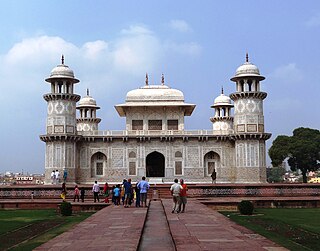
A tomb or sepulcher is a repository for the remains of the dead. It is generally any structurally enclosed interment space or burial chamber, of varying sizes. Placing a corpse into a tomb can be called immurement, although this word mainly means entombing people alive, and is a method of final disposition, as an alternative to cremation or burial.

Clerkenwell is an area of central London, England.
Subterranean London refers to a number of subterranean structures that lie beneath London. The city has been occupied by humans for two millennia. Over time, the capital has acquired a vast number of these structures and spaces, often as a result of war and conflict.
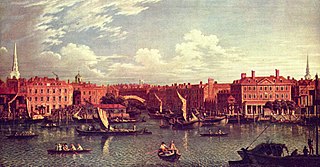
The River Fleet is the largest of London's subterranean rivers, all of which today contain foul water for treatment. It has been used as a culverted sewer since the development of Joseph Bazalgette's London sewer system in the mid-19th century with the water being treated at Beckton Sewage Treatment Works. Its headwaters are two streams on Hampstead Heath, each of which was dammed into a series of ponds—the Hampstead Ponds and the Highgate Ponds—in the 18th century. At the southern edge of Hampstead Heath these descend underground as sewers and join in Camden Town. The waters flow 4 miles (6 km) from the ponds.

The Catacombs of Rome are ancient catacombs, underground burial places in and around Rome, of which there are at least forty, some rediscovered since 1578, others even as late as the 1950s.

An underground city is a series of linked subterranean spaces that may provide a defensive refuge; a place for living, working or shopping; a transit system; mausolea; wine or storage cellars; cisterns or drainage channels; or several of these. Underground cities may be currently active modern creations or they may be historic including ancient sites, some of which may be entirely or partially open to the public.

Down Street, also known as Down Street (Mayfair), is a disused station on the London Underground, located in Mayfair, west London. The Great Northern, Piccadilly and Brompton Railway opened it in 1907. It was latterly served by the Piccadilly line and was situated between Dover Street (now named Green Park) and Hyde Park Corner stations.
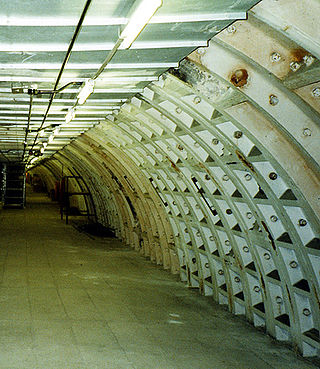
The London deep-level shelters are eight deep-level air-raid shelters that were built under London Underground stations during World War II.
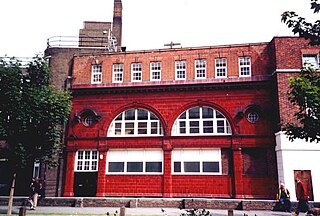
Brompton Road is a disused station on the Piccadilly line of the London Underground, located between Knightsbridge and South Kensington stations.

West Norwood Cemetery is a 40-acre (16 ha) rural cemetery in West Norwood in London, England. It was also known as the South Metropolitan Cemetery. One of the first private landscaped cemeteries in London, it is one of the "Magnificent Seven" cemeteries of London, and is a site of major historical, architectural and ecological interest.

A hypogeum or hypogaeum is an underground temple or tomb.

The Odessa catacombs are a labyrinth-like network of tunnels located under the city of Odessa and its outskirts in Ukraine, that are mostly the result of stone mining, particularly coquina. The system of Odessa Catacombs consists of a network of basements, bunkers, drainage tunnels and storm drains as well as natural caves.

Crystal Palace (High Level) was a railway station in South London. It was one of two stations built to serve the new site of the Great Exhibition building, the Crystal Palace, when it was moved from Hyde Park to Sydenham Hill after 1851. It was the terminus of the Crystal Palace and South London Junction Railway (CPSLJR), which was later absorbed by the London, Chatham and Dover Railway (LCDR). The station closed permanently in 1954. As of June 2024, however, restoration work on the Grade II listed subway, that led to the exhibition halls, was underway using £2.8m of grant funding; on completion, the station is expected to be removed from the Heritage at Risk Register.

The Catacombs of San Gennaro are underground paleo-Christian burial and worship sites in Naples, Italy, carved out of tuff, a porous stone. They are situated in the northern part of the city, on the slope leading up to Capodimonte, consisting of two levels, San Gennaro Superiore, and San Gennaro Inferiore. The catacombs lie under the Rione Sanità neighborhood of Naples, sometimes called the "Valley of the Dead". The site is now easily identified by the large church of Madre del Buon Consiglio.

A burial vault is a structural stone or brick-lined underground tomb or 'burial chamber' for the interment of a single body or multiple bodies underground. The main difference between entombment in a subterranean vault and a traditional in-ground burial is that the coffin is not placed directly in the earth, but is placed in a burial chamber specially built for this purpose. A burial vault refers to an underground chamber, in contrast to an above-ground, freestanding mausoleum. These underground burial tombs were originally and are still often vaulted and usually have stone slab entrances. They are often privately owned and used for specific family or other groups, but usually stand beneath a public religious building, such as a church, or in a churchyard or cemetery. A crypt may be used as a burial vault and a freestanding mausoleum may contain a burial vault beneath the ground.
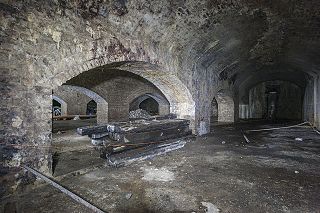
The Camden Catacombs are a system of underground passages in Camden Town in north London underneath part of the Camden markets, constructed in the 19th century, and as of 2012 owned by Network Rail. They are not true catacombs as they were never used as repositories for dead bodies, instead being an underground area originally used as stables for horses and pit ponies working on the railways.

Clerkenwell (old) Prison, also known as the Clerkenwell House of Detention or Middlesex House of Detention was a prison in Clerkenwell, London, opened in 1847 and demolished in 1890. It held prisoners awaiting trial.
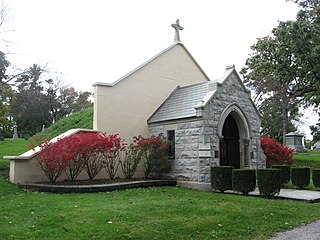
A receiving vault or receiving tomb, sometimes also known as a public vault, is a structure designed to temporarily store dead bodies in winter months when the ground is too frozen to dig a permanent grave in a cemetery. Technological advancements in excavation, embalming, and refrigeration have rendered the receiving vault obsolete.



















